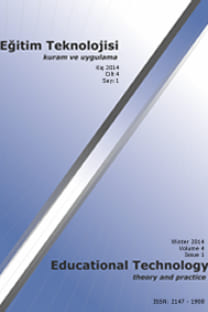ÇEVRİMİÇİ ÖDEV GÖNDERME VE DÖNÜT ALMA SÜRECİNDE ÖĞRENCİ KATILIM DAVRANIŞLARI
çevrimiçi öğrenme, yansıtıcı düşünme, dönüt, öğrenci davranışı
STUDENT ENGAGEMENT BEHAVIORS IN THE PROCESS OF ONLINE ASSIGNMENT AND FEEDBACK
online learning, reflective thinking, feedback, student behavior,
___
- Akbaba, R. S., & Türel, Y. K. (2016). Yazma becerisinde dönüt ve dönüt aracı olarak kullanılan bilgisayara ilişkin bir derleme çalışması. Uluslararası Türkçe Edebiyat Kültür Eğitim Dergisi, 5(4), 2023-2040.
- Biesinger, K., & Crippen, K. (2010). The effects of feedback protocol on self-regulated learning in a web-based worked example learning environment. Computers & Education, 55(4), 1470-1482.
- Boas, I. V. (2011). Process writing and the internet: Blogs and Ning networks in the classroom. English Teaching Forum, 49(2), 26-33.
- Bonnel, W. (2008). Improving feedback to students in online courses. Nursing Education Perspectives, 29(5), 290-294.
- Colasante, M. (2011). Using video annotation to reflect on and evaluate physical education pre-service teaching practice. Australasian Journal of Educational Technology, 27(1), 66-88.
- Coulter, G. A., & Grossen, B. (1997). The effectiveness of in-class instructive feedback versus after- class instructive feedback for teachers learning direct instruction teaching behaviors. Effective School Practices, 16(4), 21–35.
- Creswell, J. W. (2003). Qualitative, quantitative and mixed methods approaches. CA: Sage Publications.
- Cronje, J. C. (2001). Metaphors and models in Internet-based learning. Computers & Education, 37(3-4), 241-256.
- Çalışkan, H. (2015). Sosyal bilgiler öğretmenlerinin yapılandırmacı öğrenme ortamlarını düzenleme düzeylerinin çeşitli değişkenlere göre incelenmesi. Journal of Social Studies Education Research, 6(1), 49- 83.
- Çiftçi, H. (2009). The Effect of Blog Peer Feedback on Turkish EFL Students’ Writing Performance and Their Perceptions. Yayımlanmamış Yüksek Lisans Tezi. Yeditepe Üniversitesi, İstanbul.
- Ergin, A. (1995). Öğretim teknolojisi, iletişim. Ankara: Pegem Yayıncılık.
- Fraenkel, J. R., Wallen, N. E., & Hyun, H. H. (2012). How to design and evaluate research in education (8th ed.). New York: McGraw-Hill.
- Gallien, T., & Oomen-Early, J. (2008). Personalized versus collective instructor feedback in the online courseroom: Does type of feedback affect student satisfaction, academic performance and perceived connectedness with the instructor?. International Journal on E-learning, 7(3), 463-476.
- Getzlaf, B., Perry, B., Toffner, G., Lamarche, K., & Edwards, M. (2009). Effective instructor feedback: Perceptions of online Graduate students. Journal of Educators Online, 6(2), n2.
- Gordijn, J., ve Nijhof, W. J. (2002). Effects of complex feedback on computer-assisted modular instruction. Computers & Education, 39(2), 183-200.Hatziapostolou, T., & Paraskakis, I. (2010). Enhancing the impact of formative feedback on student learning through an online feedback system. Electronic Journal of e-Learning, 8(2), 111-122.
- Kangalgil, F. (2013). The differential transform method for solving one-dimensional burger's equation and k (m, p, 1) equation. Cumhuriyet Üniversitesi Fen-Edebiyat Fakültesi Fen Bilimleri Dergisi, 34(3), 29-40.
- Karadağ, E. (2010). Eğitim bilimleri doktora tezlerinde kullanılan araştırma modelleri: Nitelik düzeyleri ve analitik hata tipleri. Kuram ve Uygulamada Eğitim Yönetimi, 1(1), 49-71.
- Kember, D., Leung, D., Jones, A., Loke, A., McKay, J., Sinclair, K., Tse, H., Webb, C., Wong, F., Wong, M., ve Yeung, E. (2000). Development of a questionnaire to measure the level of reflective thinking. Assessment and Evaluation in HigherEeducation, 25(4), 381-395.
- Kop, R., & Hill, A. (2008). Connectivism: Learning theory of the future or vestige of the past. International Review of Research in Open and Distance Learning, 9(3), 1-13.
- Krefting, L. (1991). Rigor in qualitative research: The assessment of trustworthiness. American Journal of Occupational Therapy, 45(3), 214-222.
- Neuman, W. L. (2010). Toplumsal araştırma yöntemleri: Nicel ve nitel yaklaşımlar I-II. (S. Özge, Çev.). İstanbul: Yayın Odası Yay.
- O’Reilly, M. F., Renzaglia, A., & Lee, S. (1994). An analysis of acquisition, generalization and maintenance of systematic instruction competencies by preservice teachers using behavioral supervision techniques. Education and Training in Mental Retardation and Developmental Disabilities, 29(1), 22–33.
- Paker, T. (2008). Öğretmenlik uygulamasında öğretmen adaylarının uygulama öğretmeni ve uygulama öğretim elemanının yönlendirmesiyle ilgili karşılaştıkları sorunlar. Pamukkale Üniversitesi Eğitim Fakültesi Dergisi, 23(23), 132-139.
- Smith, P.L., & Ragan, T.J. (2005). Instructional design (3rd ed). New York: Merill.
- Stone, A. (2014). Online assessment: what influences students to engage with feedback?. The clinical teacher, 11(4), 284-289.
- Timmers, C., & Veldkamp, B. (2011). Attention paid to feedback provided by a computer-based assessment for learning on information literacy. Computers & Education, 56(3), 923-930.
- Tzetzis, G., & Votsis, E. (2006). The effect of different feedback methods on badminton skills acquisition and retention. Perceptual and Motor Skills, 102, 275-284.
- van der Kleij, F. M., Eggen, T. J., Timmers, C. F., & Veldkamp, B. P. (2012). Effects of feedback in a computer-based assessment for learning. Computers & Education, 58(1), 263-272.
- Wolsey, T. (2008). Efficacy of instructor feedback on written work in an online program. International Journal on E-learning, 7(2), 311-329.
- Yıldırım A., & Şimşek H. (2012). Sosyal bilimlerde nitel araştırma yöntemleri. Ankara: Seçkin Yayıncılık.
- Yılmaz, R., Gümüş, S., & Okur, M.R. (2005). Türkiye’de yüksek örgün öğrenimde çevrimiçi öğrenme. Paper presented at 5th International Educational Technology Conference, Sakarya University, Adapazarı, September 21-23, 2005.
- ISSN: 2147-1908
- Yayın Aralığı: Yılda 2 Sayı
- Başlangıç: 2011
- Yayıncı: Tolga Güyer
ÖĞRENCİLERİN STEM KARİYER TERCİHLERİNİN VERİ MADENCİLİĞİ YAKLAŞIMI İLE TAHMİN EDİLMESİ
Gökhan AKÇAPINAR, Erdal COŞGUN
E-ÖĞRENME ORTAMLARINDA ALGILANAN KARMAŞIK GÖREV PERFORMANS ÖLÇEĞİ
Sacide Güzin MAZMAN AKAR, Arif ALTUN
HERKÜL’ÜN HİKÂYESİ: EĞİTSEL BİR OYUN GELİŞTİRME MODELİ ÖNERİSİ
Fatma BAYRAK, Pınar NUHOĞLU, Şeyma ÇAĞLAR ÖZHAN, Selay Arkün KOCADERE
3B TASARIM ÖĞRENME DENEYİMİNİN SÜREÇ DEĞERLENDİRMESİ VE EĞİTSEL ÇIKTILARININ KEŞFEDİLMESİ
Akça Okan YÜKSEL, Burcu BERİKAN, Ekmel ÇETİN
Yıldız ÖZAYDIN AYDOĞDU, Şeyhmus AYDOĞDU, Mehmet Akif OCAK
Ayşe BAĞRIACIK YILMAZ, Serçin KARATAŞ
Deniz ATAL, Raziye SANCAR, Deniz DERYAKULU
EĞİTİMDE SANAL GERÇEKLİK UYGULAMALARINDA ERİŞİLEBİLİRLİK VE UYUMLULUK
Mehmet BÜTÜN, Veli Özcan BUDAK, Murat SELÇUK, İlkim Ecem EMRE, İrfan ŞİMŞEK
VİDEO KAPILMA ÖLÇEĞİNİN UYARLAMA, GEÇERLİK VE GÜVENİRLİK ÇALIŞMASI
Deniz DERYAKULU, Raziye SANCAR, Ömer Faruk URSAVAŞ
BİLİŞİM TEKNOLOJİLERİ ALANINDA MESLEK SEÇİMİNİ YORDAYAN DEĞİŞKENLER
